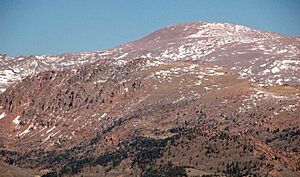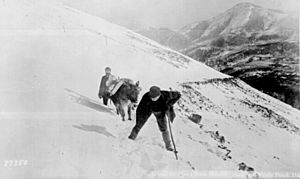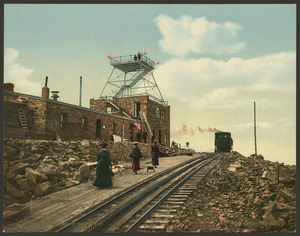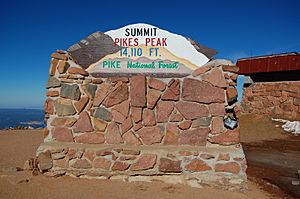Pikes Peak facts for kids
Quick facts for kids Pikes Peak |
|
|---|---|
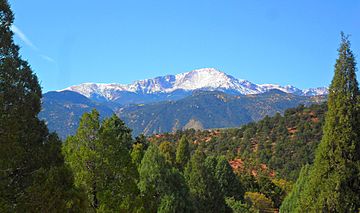
Pikes Peak, east aspect
|
|
| Highest point | |
| Elevation | 14,115 feet (4,302.31 m) NAVD88 |
| Prominence | 5,530 feet (1,690 m) |
| Isolation | 60.6 mi (97.6 km) |
| Listing |
|
| Naming | |
| Etymology | Zebulon Pike |
| Native name | Error {{native name}}: an IETF language tag as parameter {{{1}}} is required (help) |
| Geography | |
| Location | High point of El Paso County, Colorado, United States |
| Parent range | Front Range, Highest summit of the Pikes Peak Massif |
| Topo map | USGS 7.5' topographic map Pikes Peak, Colorado |
| Geology | |
| Age of rock | ~1.05 Gyr |
| Mountain type | granite |
| Climbing | |
| First ascent | 1820 by Edwin James and party |
| Easiest route | East Slopes (Barr Trail): Hike, class 1 |
Pikes Peak is a very tall mountain in the Rocky Mountains of North America. It stands at 14,115-foot (4,302.31 m) high. This makes it one of the highest mountains in the area. You can find it in Pike National Forest, about 12 miles (19 km) west of Colorado Springs, Colorado. The town of Manitou Springs is right at its base.
The mountain is named after an American explorer, Zebulon Pike. He tried to climb it but couldn't reach the top. Pikes Peak is actually higher than any other point in the United States to its east.
Contents
Mountain Names Through Time
The Tabeguache Ute people lived around Pikes Peak for a long time. They called the mountain Tava, which means "sun" in their language. Their stories say they were created on Tava. Later, the Arapaho people arrived and called it Heey-otoyoo', meaning "Long Mountain."
Over the years, European explorers gave the mountain many names. Some of these names were El Capitán, Grand Peak, and James Peak.
Spanish explorers first called it "El Capitán," meaning "The Leader." In 1806, American explorer Zebulon Pike named it "Highest Peak." Later, it was often called "Pike's Highest Peak." Another explorer, Stephen Harriman Long, named it "James Peak." This was to honor Edwin James, who was the first to climb it in 1820. Eventually, the mountain was renamed "Pike's Peak" for Zebulon Pike. In 1890, the name was simplified to "Pikes Peak."
How Pikes Peak Was Formed
Pikes Peak is one of Colorado's 54 "fourteeners." These are mountains that are more than 14,000 feet (4,267.2 m) above sea level. The mountain rises over 8,000 ft (2,400 m) above Colorado Springs. Pikes Peak is a special place, recognized as a National Historic Landmark.
The mountain is made of a unique pink rock called Pikes Peak granite. This pink color comes from a lot of potassium feldspar in the rock.
Scientists believe this granite started as hot, melted rock called magma. It cooled and hardened deep underground, about 20 miles (32 km) below the Earth's surface. This happened about 1.05 billion years ago. Over millions of years, the hardened rock was pushed up by Earth's forces. This created a dome-shaped mountain. Wind and water then wore away the softer rock and soil. This left the hard granite mountain we see today.
The soil on Pikes Peak changes with height. Above the tree line (around 12,000 ft (3,700 m)), the soil is called Cirque land. Lower down, in the forests, the soil is mostly brown, stony, and sandy.
Devils Playground
The Devils Playground is a smaller peak on the northwest side of Pikes Peak. It's close to the Pikes Peak Highway. This area got its name because lightning often seems to "dance" around it during storms. The Devils Playground is the highest point in Teller County. It is about 13,075 feet (3,985 m) high.
First Sightings and Climbs
The first Europeans to see Pikes Peak were the Spanish in the 1700s. The first American sighting is often given to Zebulon Pike and his team in 1806. Pike tried to climb it in November 1806 but couldn't. He wrote in his journal about the deep snow and freezing temperatures. He realized his soldiers were not prepared for such a cold climb. He decided they had to turn back.

The first European to successfully climb Pikes Peak was Edwin James. This happened 14 years after Pike's attempt, in the summer of 1820. James was a young student and a botanist on an expedition. He and two other men left their main group. They climbed the peak in two days. On their way, James was the first to describe the blue columbine. This flower is now Colorado's state flower.
In 1858, gold was found near what is now Denver. Newspapers called this gold area "Pike's Peak." The saying "Pike's Peak or Bust" became famous during the Colorado Gold Rush. This was because Pikes Peak was easy to see for gold seekers traveling west. However, most of the gold was not actually near Pikes Peak itself. Major gold discoveries in the Pikes Peak area happened later, in 1893. This was in the Cripple Creek Mining District.
In 1860, a company called Clark, Gruber and Company started making gold coins in Denver. These coins had "Pike's Peak Gold" written on them. They also showed a picture of the peak. Later, in 1863, the U.S. Treasury bought their equipment. This led to the opening of the Denver Mint.
In 1858, Julia Archibald Holmes became the first European-American woman to climb Pikes Peak. She reached the summit on August 5. She wrote to her mother from the top, saying she was glad she didn't miss "this glorious sight."
Many years later, in July 1893, Katharine Lee Bates wrote the famous song "America the Beautiful." She was inspired by the amazing view from the top of Pikes Peak. The song was first published in 1895. There is a plaque at the summit today that honors the words to her song.
On July 17, 1913, William Wayne Brown drove his car, the Bear Cat, to the summit. It took him 5 hours and 28 minutes to drive the 20 miles (32 km) to the top.
The very top part of Pikes Peak was named a National Historic Landmark in 1961. This means it's a very important historical place. Pikes Peak even had a ski resort from 1939 until 1984.
Pikes Peak Today
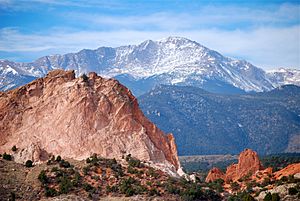

Today, many people visit Pikes Peak. There are visitor centers with gift shops and restaurants. You can find these at the 6-mile (9.7 km) and 12-mile (19 km) points on the toll road. There's also a center right at the summit.
At the Summit House, they sell special high-altitude doughnuts. They make up to 700 doughnuts an hour! These doughnuts are unique because they collapse if you take them to lower altitudes.
There are a few ways to get to the top of the mountain.
- The Manitou and Pike's Peak Railway is the world's highest cog railroad. It takes people from Manitou Springs all the way to the summit. It closed for repairs in 2017 but reopened on May 27, 2021.
- You can also drive to the summit using the Pikes Peak Highway. This is a 19 mi (31 km) road that starts near Cascade. The road has many sharp turns called "The W's." These turns can be tricky if you drive too fast. The city of Colorado Springs takes care of this road as a toll road. The entire road was paved by 2011. This paving helped protect the environment from gravel and dirt washing off the road. In 2023, the toll cost US$15 for people 16 and older. It was US$5 for kids aged 6 to 15.
- The Highway is famous for the annual Pikes Peak International Hill Climb. This is a motor race that has been held since 1916. There's also a cycling race called the Pikes Peak Cycling Hill Climb.
The most popular way to hike to the top is the Barr Trail. This trail starts in Manitou Springs. It's a long and tough hike, about 13 mi (21 km) one-way. You gain almost 8,000 ft (2,400 m) in height. The Pikes Peak Marathon is a race that goes up and down this trail. Another hiking path, called Class 2, starts at Crags Campground on the west side.
Since 1922, a group called the AdAmAn Club climbs Pikes Peak every year. They start on December 30th and reach the top on December 31st. At midnight on New Year's Eve, they set off fireworks from the summit!
Since 1969, the summit has also been home to the United States Army Pikes Peak Research Laboratory. This lab studies how high altitude affects people.
A new Summit Complex is being built next to the old one. It's a big project that started in 2018. The new building will have a visitor center and research labs. It's designed to be very eco-friendly. Working on the mountain is hard because of the high altitude and cold ground.
On July 20, 2023, a small tornado touched down on the mountain. It traveled 2 miles along the highway. Winds reached 108 mph, snapping trees. Luckily, no one was hurt.
Mountain Climate
At the top of Pikes Peak, there is less oxygen in the air. The air pressure is lower, so water boils at a cooler temperature. It boils at 186 °F (86 °C) instead of 212 °F (100 °C) at sea level.
People and animals need to breathe faster at high altitudes. Some people might get Altitude sickness if they are not used to the height.
The summit of Pikes Peak has a very cold climate, like the North and South Poles. Snow can fall any time of year. Thunderstorms with strong winds, sometimes over 100 miles per hour (160 km/h), are common in the afternoons.
Areas around Pikes Peak have different climates. Lower areas might have a drier, semi-desert climate. Other areas might be cooler, like a northern forest.
See also
 In Spanish: Pico Pikes para niños
In Spanish: Pico Pikes para niños




